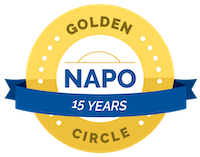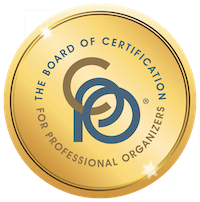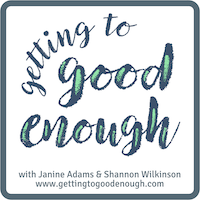Worth repeating (again): Small irritations
I originally wrote this post back in 2010 and repeated it in 2013. When I read it again today, I decided to run it again because the message rings so true. Often, little bits of friction are enough to keep us from moving forward with our goals. I had taken a bit of a hiatus from my knitting but became rejuvenated when I decluttered my knitting projects last summer. (I’ll post about that soon!) So this post resonated with me today. I hope you enjoy it.
Sometimes the tiniest things keep us from doing things we want to do or think we should be doing. If we can identify those things and modify them, we can get more done.
I was thinking about this as I contemplated my knitting. One of the projects I’m working on is this cool bag, the Garter Stripe Square Bag. (The pattern is in Japanese, but you can find it in English on Ravelry.)

This bag was created (and photographed) by LKolarik on Ravelry.
To make this bag, you knit 22 striped squares, seam them together in a particular way, sew the sides of the bag, create handles and throw the whole thing into the washing machine to felt it. The knitting part is easy, the construction perhaps a tiny bit complicated. But overall, it’s a very cool result for minimal effort. Good, mindless knitting.
I started knitting the striped squares on my favorite knitting needles, Harmony interchangeable circular needles from Knit Picks. I love the Harmony needles because they’re smooth and light and just feel great. (I’m not crazy about the way they look, but I’ve gotten past that.)
But as I researched this project more on Ravelry, I saw that other people had knit it on double-pointed needles (DPNs), picking up stitches on the side of finished squares to minimize the seaming. (If you’re not a knitter, the takeaway is that I thought I’d try different needles.)
So I bought some bamboo DPNs at my local yarn shop. They’re perfectly serviceable needles, but they don’t have the smooth finish of the Harmony. (I could have purchased Harmony DPNs, but they’re only available mail order and I didn’t want to wait.)
When I started to knit a square with these new needles, it was less pleasant. There was a certain drag to the needles, making the knitting more laborious. There was some friction in the combination of the wool and the bamboo that felt yucky. I would do just a couple of rows before putting the square down.
Eventually I decided to give up on the DPNs and go back to the Harmony needles. Now I’m buzzing along on my squares.
The lesson here? It took me awhile to figure out the reason I was resisting knitting that bag was that I hated the way the needles felt. They transformed the knitting experience from something enjoyable into something irritating.
This happens all the time in life. Maybe you’d be more inclined to put a certain item away if it were stored in a more accessible place. Maybe you’d handle your mail every day if you had a clear, designated space in which to do it. Maybe you’d put your laundry away promptly if the drawers weren’t so full of clothes.
Think about an order-related task you’re resisting. Is there some small change you could make that would make doing it easier? Some little irritation you can identify that you could remove or modify? One little change can make a big difference.
Becoming a Certified Professional Organizer®
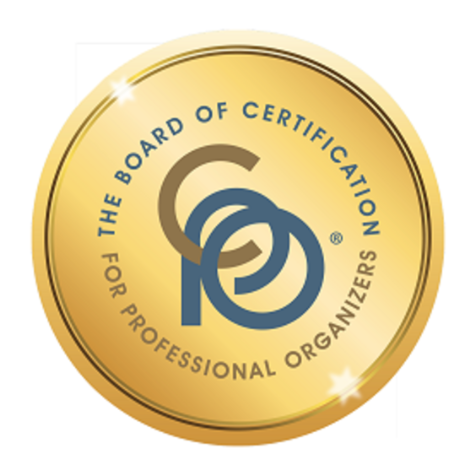
Recently, I received a comment on my popular blog post Are you interested in becoming a professional organizer? that reminded me that there’s a certain amount of confusion among new or aspiring professional organizers about the Certified Professional Organizer credential. I’m a proud CPO® so I thought I’d take the opportunity to try to clear up some of the confusion.
First some background. The Certified Professional Organizer credential was created by and is governed by the Board of Certification for Professional Organizers® (BCPO®) which was started by NAPO, the National Association of Productivity and Organizing Professionals®. It came about through the hard work of dedicated volunteers who wanted to create a meaningful credential that furthers the mission of advancing the credibility and ethical standards of the organizing industry. BCPO follows the accreditation guidelines set forth by the National Commission for Certifying Agencies (NCAA). It’s the real deal.
I’ve been around long enough to remember the thrill of a large group of brave organizers sitting for the inaugural exam at the NAPO conference in 2007. I was not one of those organizers, because at that point I didn’t qualify to sit for the exam. (But I did hang around outside the ballroom where testing was taking place to congratulate those who took it. That’s how big a deal it was to me.) I qualified the following year and earned my CPO in 2008.
Here are some things you need to know about becoming a CPO:
- In order to qualify to take the exam, you must have 1500 paid client hours or 1250 paid clients and 250 qualified educational hours in the past five years. (Note: the eligibility period for those 1500 hours was raised from three years to five years in 2019, making qualifying for the exam more attainable for many. I applaud that change.)
- Once you’ve qualified, you must sit for an exam at a testing center and pass it. The exam consists of 125 multiple-choice questions.
- You’re responsible for keeping track of your qualifying hours. A certain percentage of people who pass the test are audited and asked to show the documentation of their hours. If their hours aren’t documented, they don’t earn the credential.
- To maintain your CPO status, you must take an average of 15 continuing education units (CEUs) every year. You recertify every three years with 45 CEUs.
- There is a cost associated with taking the exam (currently $450) and a cost associated with maintaining the credential (currently $100 a year).
- CPOs are required to adhere to a strict Code of Ethics.
- You do not have to be a member of NAPO to be a CPO.
It’s pretty simple, really. One thing that seems obvious to me but isn’t apparently obvious to those new to the field is that you don’t have to be certified in order to work as a professional organizer. In fact, you can’t be certified until you’ve had substantial experience as a professional organizer. So the CPO credential is something to aspire to (if you’re into credentials) and work toward. It’s not something you start out with.
For a deep dive into the exam itself and preparing for it, check out the BCPO Handbook for the CPO exam.
Certification vs certificates
You can, however, earn certificates (not certification) early on in your career. NAPO offers five specialist certificates. As of this writing in October 2019, NAPO is currently offering the following specialist certificates:
- Residential Organizing
- Household Management
- Life Transitions
- Workplace Productivity
- Team Productivity
The Institute for Challenging Disorganization® also offers certificates of study and specialist certificates. And they have a separate, completely different certification credential, Certified Professional Organizer in Chronic Disorganization® that’s also very rigorous to achieve. I attained the CPO-CD® credential in 2009, though I chose not to recertify in 2015. The CPO-CD credential is not the same as CPO. (Obviously, an organizer can have both.) See the Certification page on ICD’s website for an overview of their program.
If you earn NAPO’s specialist certificates (or certificates from other organizations), that’s fantastic. But you can’t call yourself a Certified Professional Organizer unless you qualify to sit for, then pass, the CPO exam as outlined above.
Is it worth it to become a CPO?
I took the exam as soon as I qualified, which was a year after the credential became available. That meant I was the first CPO in the St. Louis area and remain one of only three CPOs in St. Louis and four in the state of Missouri. (There are approximately 350 CPOs in the world. Fourteen of them are from outside the United States.) That puts me in an elite group that I am proud to be a part of. When I got my CPO, I raised my rates with confidence. So for me, it’s worth it for the marketing value and the confidence it gives my clients and prospective clients in my abilities and ethics. I consider it very prestigious.
Is it necessary for a successful professional organizer to become CPO? Absolutely not. I know many, many excellent organizers who have either not had the hours to qualify or simply did not care to pursue the credential. I do admire those who invest the effort and expense of getting certified and staying certified, however.
To learn more about becoming a Certified Professional Organizer, check out the Certified Professional Organizer page on the NAPO website for loads of information and resources.
Downsizing advice: My interview on Generations Cafe podcast
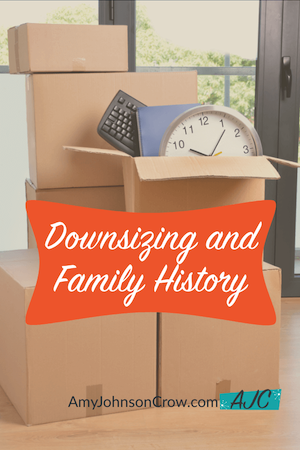
Amy Johnson Crow, a well-known genealogist, blogger and speaker, is one of my favorite genealogy luminaries. She offers fabulous advice. And I’m delighted to call her my friend.
So I was thrilled when Amy asked me to be a guest on her podcast, Generations Cafe. She and I had a great discussion about downsizing and figuring out what to let go of—both our own items and those of our parents. As genealogists we are both very sensitive to the value that family possessions might (or might not) have for future generations, which can make downsizing especially tricky. I was able to share my perspective as someone who’s spent a lot of time helping people let go of stuff.
The episode is called Downsizing and Family History. It’s a 36-minute interview. If you have a spare half hour, I urge you to give it a listen. I may be a little biased, but I think it’s interesting and enjoyable!
Completing a jigsaw puzzle five pieces at a time
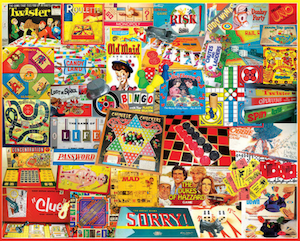
I enjoy doing jigsaw puzzles. One-thousand-word puzzles are just the right size and my favorite kind to do are collage puzzles. I think I like collages because of all the easy sorting that can be done. And the frequent sense of accomplishment.
Last month I completed a 1000-word collage puzzle five pieces at a time and mentioned it on Episode 68 of Getting to Good Enough, the podcast I host with Shannon Wilkinson. I’m just about to finish another puzzle using this method, which I devised for myself, and I find the method so successful (and relevant to other parts of my life) that I thought I’d share.
I do jigsaw puzzles at the end of our dining-room table. There’s room there, since there are only two us of eating (unless we have guests). But I don’t want a puzzle to languish there untended. I also don’t have hours a day to devote to doing puzzles. And I don’t want to wreck my productivity on a workday by getting sucked into a puzzle. So here’s what I do.
I start by connecting the edge pieces of the puzzle, which has always been my favorite part of the puzzle. (I can’t imagine working on the interior with the edges set up…I wonder what that says about me?)
Once I have the edge pieces connected, I tell myself that I will connect five puzzle pieces and then I’ll stop. That’s it. It’s that easy.
Much of the time in the early stages of completing a puzzle is spent sorting. With collage puzzles, I sort pieces into likely sets. I use empty boxes for the sorting. (At last! a use for those Apple boxes I can’t seem to throw away.) To achieve my pieces, I will connect pieces within those sets and/or I’ll connect pieces within the puzzle itself. If I connect a group of already-connected pieces into the puzzle, that counts as one piece.
This is the puzzle I’m currently working on (The Games We Play from White Mountain Puzzles), taken a week ago.

Here are some of the boxes of sets.

And here is the puzzle this morning. I’m almost finished! This puzzle has been particularly enjoyable.

As I see it, here are some of the benefits of my five-pieces-at-a-time method:
- It makes the puzzle feel very achievable
- The goal is so small I can easily grab a little pocket of time to do it, so the puzzle doesn’t languish
- I get to enjoy working on the puzzle many times a day
- I don’t get so caught up in the puzzle that I don’t go to bed or work (it’s kind of like setting a timer)
- I get the pleasure of watching the puzzle emerge slowly
- I get to enjoy little achievements over and over again while doing the puzzle
I think that last point might be most important and also really relevant to other (non-puzzle) tasks. By setting tiny goal after tiny goal, I get the thrill of achievement each step of the way. I am literally never frustrated by a puzzle because I can always find five pieces to put together. (That might be because I like collage puzzles…I think I’d find puzzles with vast swatches of monochromatic areas frustrating.)
Next time I get stalled or frustrated while working on a project, I’m going to think about how I might make it more like a jigsaw puzzle and just set my sights on connecting the next five pieces.
Worth repeating: Feeling busy? Take 5 minutes to create a little order
I wrote this post three years ago, in the midst of our kitchen renovation. I can’t tell you how many times I’ve implemented this since then. Five minutes on a timer and enough order can be created to restore sanity. I encourage you to give it a try!

When I get busy my natural messiness kicks in. Our kitchen is being renovated so disorder reigns in our house and has for the last six weeks. But even in small spaces that have nothing to do with the kitchen, like my desk, everything felt out of control this morning. I’m feeling pulled in a bunch of directions and just wasn’t taking the time to put away the stuff I could. And the clutter started getting tome.
So this morning I set my timer for five minutes and I cleared off my desktop. I recycled papers I didn’t need. Took coffee mugs away to the (temporary) kitchen and put things in their homes.
After five minutes my desk wasn’t perfect (see the photo above). But I wish I’d taken a before picture, because the improvement with just a little effort was vast. I felt so much better when I was finished. And I was able to get productive quickly—I’m always amazed how a cluttered desktop hampers my productivity. (It’s clear I need to spend some time decluttering my computer desktop…please don’t judge!)
Sometimes when you’re really busy and things are messy you think you just don’t have the time to tidy up. But I think that’s when you should take a little time—even if it’s just five minutes—to create a little order and give yourself some peace of mind.
Decluttering, tidying and cleaning are not an all-or-nothing propositions. You don’t have to wait until you have enough time to do everything. You can do just a little and enjoy some big dividends.
The beauty of an uncluttered calendar

The older I get the less I want to book myself solid with appointments and activities. An uncluttered calendar, where I’m able to pick and choose what I want to do each day, rather than rush from one appointment to another, has become my ideal.
Two weeks ago, I experienced a vivid example of how great this can be. I’m a huge fan of the musical Hamilton and had seen it four times (twice in Chicago and once in St. Louis). When I learned that the production would be closing in Chicago in January 2020, I started entering the Hamilton ticket lottery in which winners can buy a $10 ticket for the next day’s production for only $10. When you enter on the app, you select whether you want one or two tickets. I’d been going for two tickets but on this occasion I asked for one, thinking it might increase my chance to win.
About 7 pm on Saturday, August 31, I saw a notification that I had won a $10 ticket for the matinee on Sunday, September 1. I had literally nothing on my schedule for Labor Day weekend and so I was able to spring into action. I bought the ticket, booked a hotel room (at the fabulous Kimpton Gray Hotel a couple of blocks of the theater) and booked a $30 parking spot at a garage across from the hotel, using my new best friend Spot Hero. I did consider taking the train, but the margin for error wasn’t high enough if I didn’t take the 4 am train. I knew the stress of worrying about train delays would detract from my fun.
At 7 am on Sunday I headed to Chicago by myself, singing along to the Hamilton soundtrack and listening to interviews of the Chicago cast on the Hamilcast podcast. I got there in plenty of time for the 2 pm show. Once there, I was thrilled to realize that my ticket was for the second row. That’s a little too close to fully appreciate the dancing, but that was okay since I’d seen it three times before. It was so close I could see tears forming in the actors’ eyes and I actually had eye contact with dancers a couple of times. It was an astounding, completely absorbing experience from that vantage point. (The picture above was taken from my seat.)
After the show, I had a complimentary glass of wine at the hotel’s happy hour, followed by a delicious meal at the Cochon Volant Brasserie located in the same block as the hotel. And then I went to bed early because I was physically and emotionally spent. And oh so happy.
It was a tremendous experience and I am so glad that my uncluttered schedule meant that I was able to enter the lottery for the ticket and that taking the trip was a no brainer after being notified that I’d won. For me, an uncluttered schedule means I can do a lot of relaxing or enjoying hobbies. And it also means I can take advantage of spontaneous opportunities. Both of those are great for me!
Free shred event in Clayton on September 17

If you are like many of my clients and have papers waiting to be shredded and gadgets waiting to be recycled piling up in your home (and you live in the St. Louis area), you’re in luck. You can take them to Shaw Park in Clayton on Tuesday, September 17 from 10 am to noon. The event is sponsored by Commerce Bank in partnership with the City of Clayton, The Shred Truck and Nilo-Tech E-Cycling.
That morning you can bring up to six boxes or bags of shredding to the south end of the park near Forest Park Parkway. Your papers will be shredded on site by The Shred Truck. You an also bring electronic gadgets that need to be recycled by Nilo-Tech E-Cycling.
The event web page mentions “drive up service,” which sounds to me like you don’t have to get out of the car.
Here’s more information in an article on the St. Louis Post-Dispatch website.
Links
- Institute for Challenging Disorganization
- Peace of Mind Budgeting
- Getting to Good Enough podcast
- Are you interested in becoming a professional organizer?
- Ravelry
- NAPO St. Louis
- Shannon Wilkinson, life coach
- National Association of Productivity and Organizing Professionals
- Organize Your Family History

